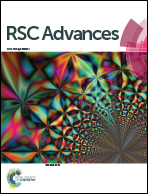Fabrication of boronic acid-functionalized nanoparticles via boronic acid–diol complexation for drug delivery
Abstract
We presented here a facile strategy for fabricating boronic acid-functionalized nanoparticles based on the complexation of phenylboronic acids in poly(3-methacrylamido phenylboronic acid) (PMAPBA) and glucose moieties in dextran via boronic acid–diol interactions. The formation of boronate crosslinked nanoparticles was confirmed by Fourier transform infrared spectrometry, thermal analysis, transmission electron micrographs, dynamic light scattering and UV spectrometry. The nanoparticles were well dispersed as individual, spherically shaped particles with an average size of 100 nm. The glucose-sensitivity was revealed by the swelling behavior of the nanoparticles at different glucose concentrations. Furthermore, insulin was encapsulated in the nanoparticles with a loading capacity up to 22%, and the structure of insulin had not been distorted in the loading procedure. The insulin release increased with the enhancement of the glucose level in the medium. More importantly, the nanoparticles had good cytocompatibility, as demonstrated by in vitro experiments. The facility of this strategy together with the high loading capacity, glucose-sensitivity and cytocompatibility of the produced nanoparticles should greatly boost their application in drug delivery.


 Please wait while we load your content...
Please wait while we load your content...